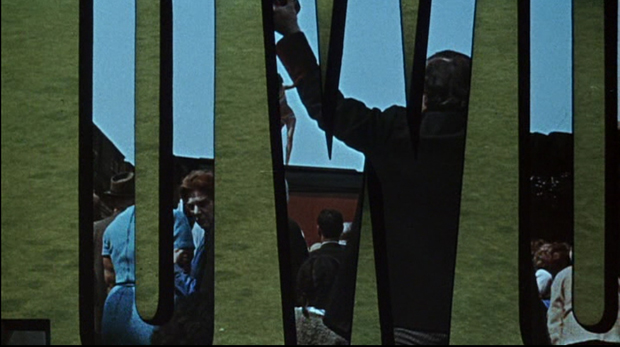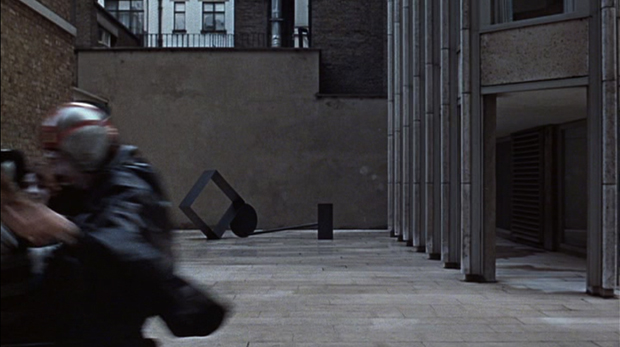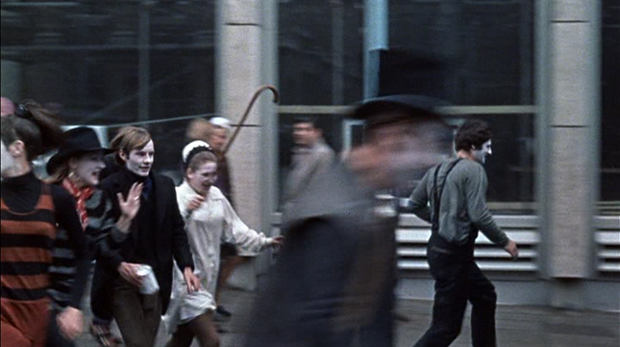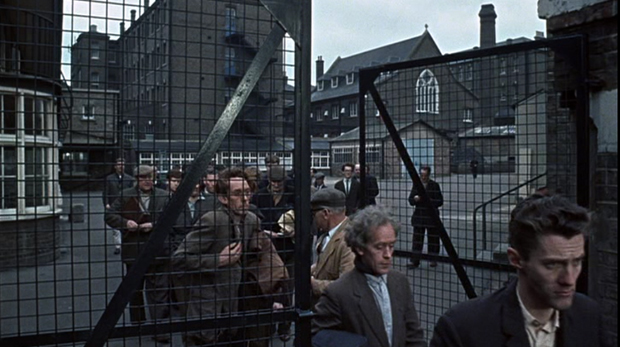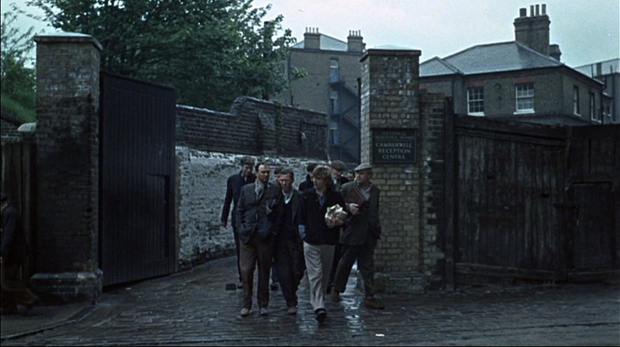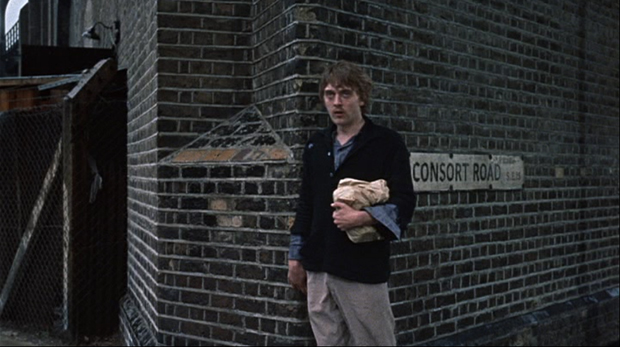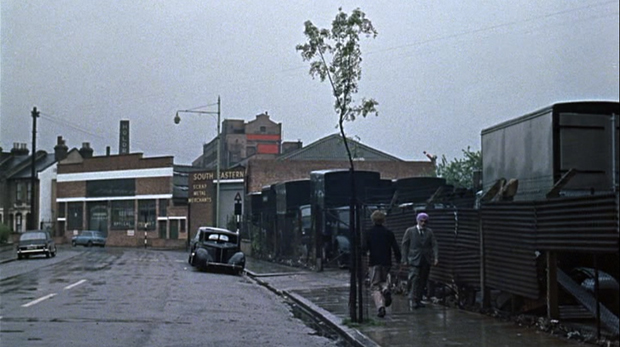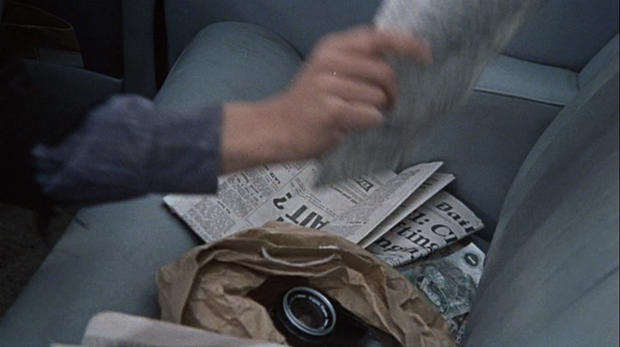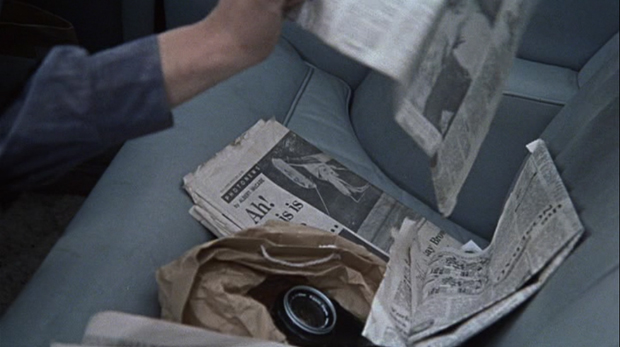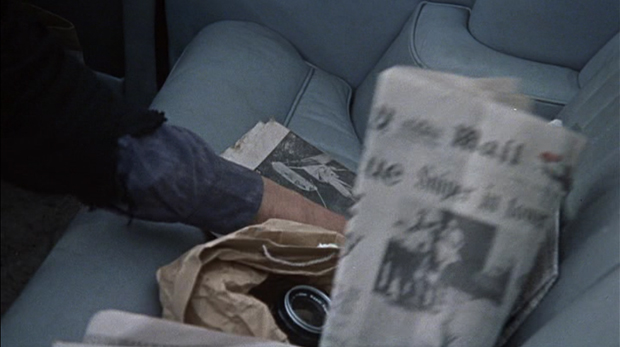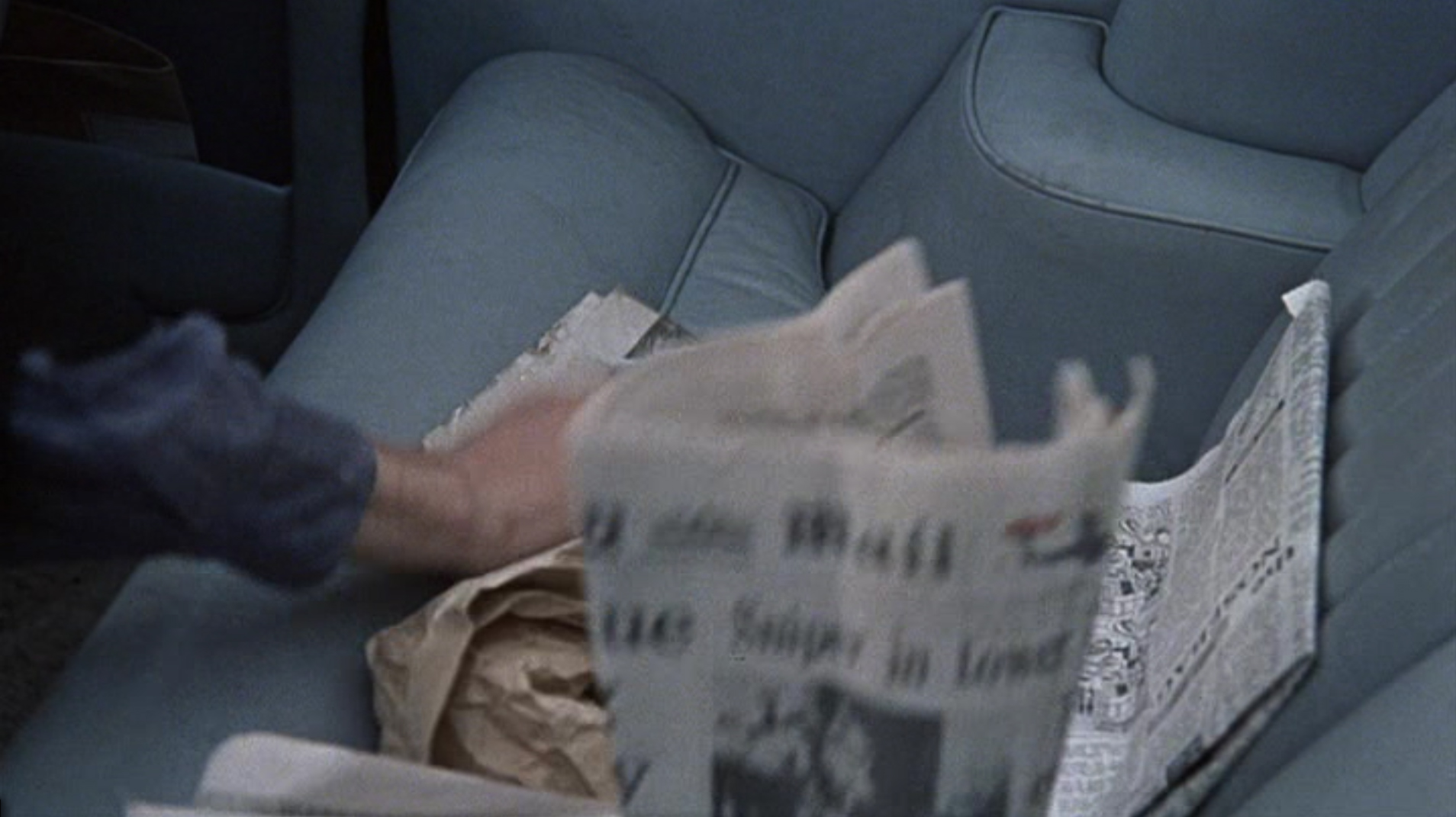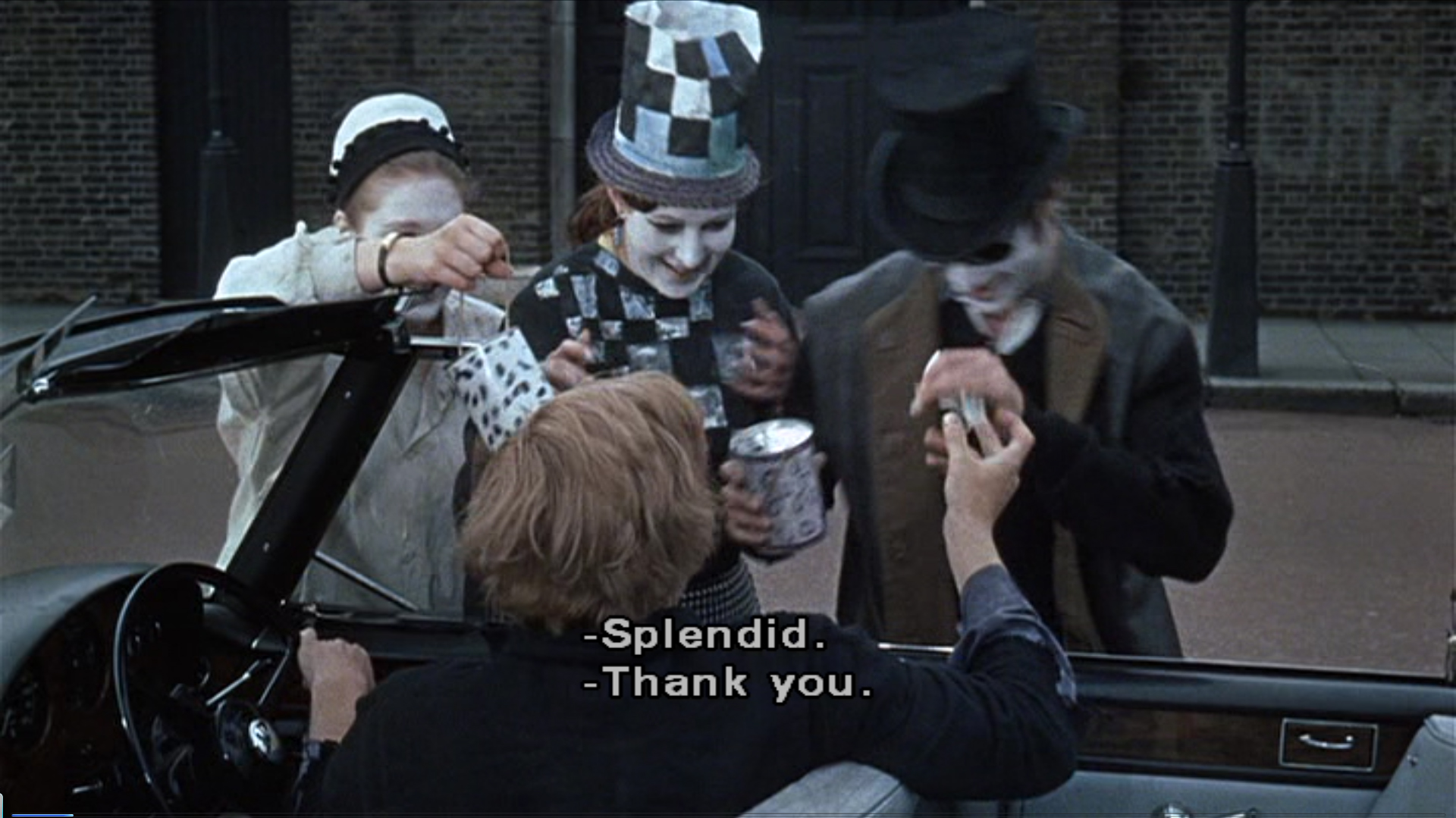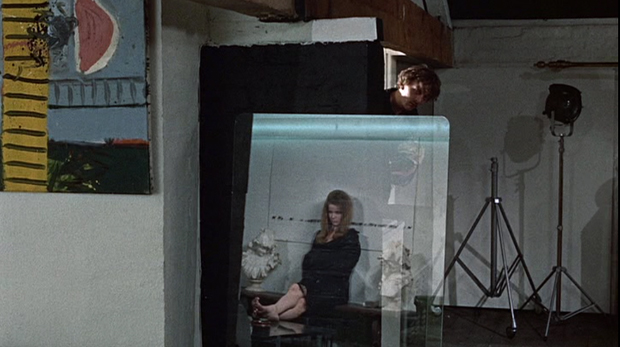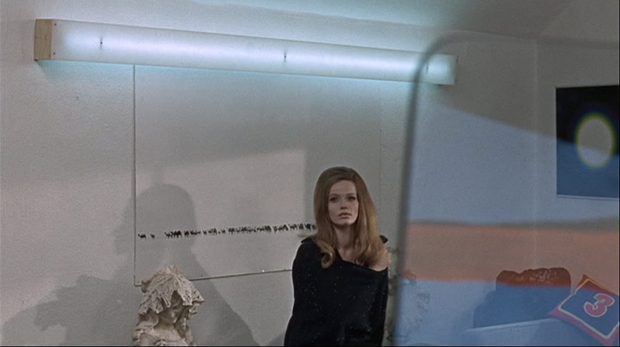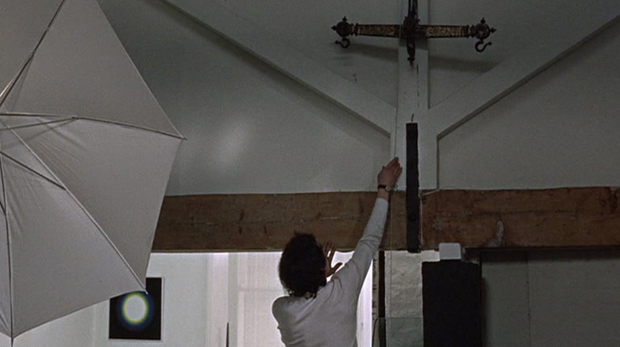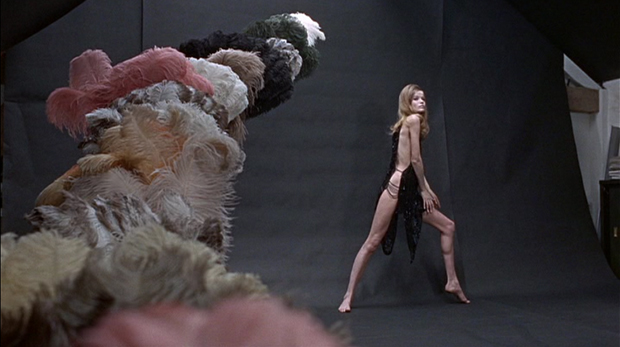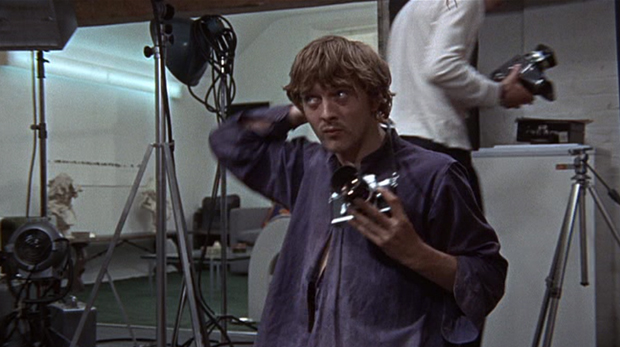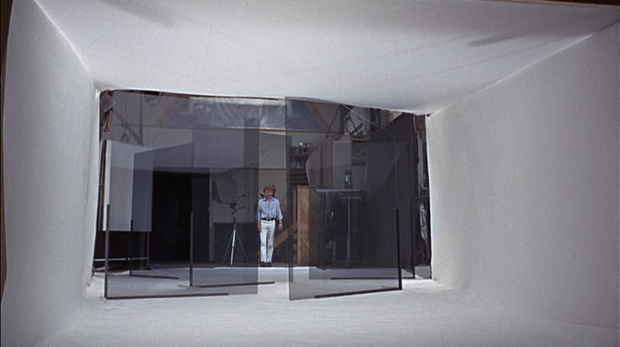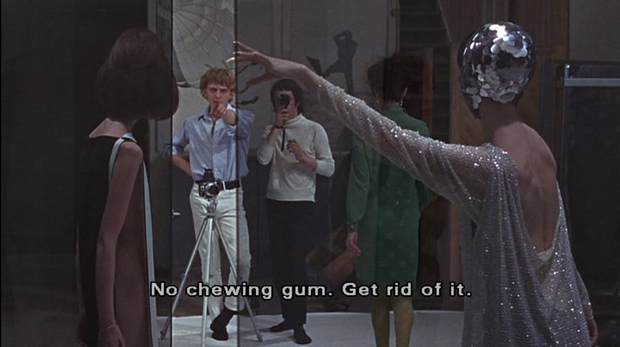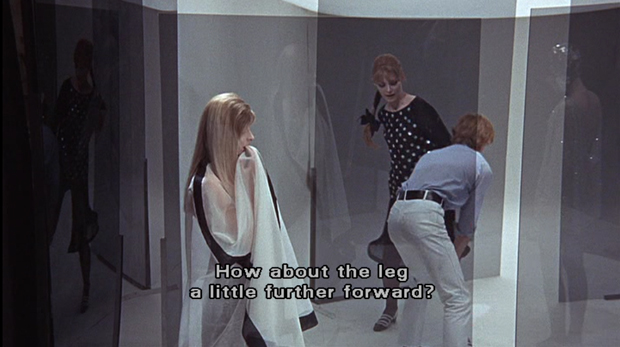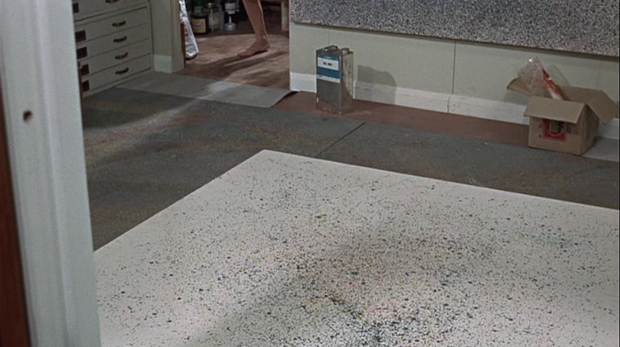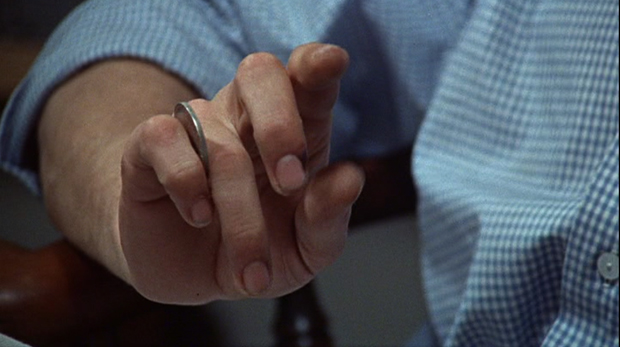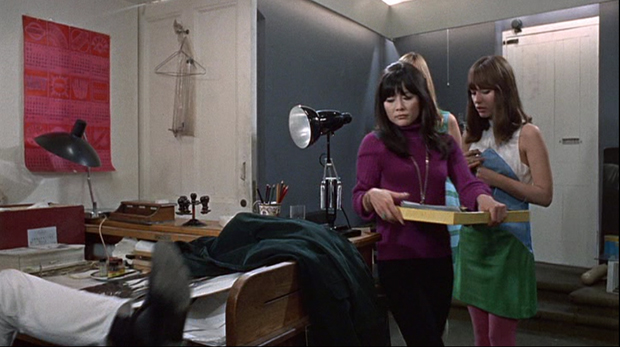MICHELANGEO ANTONIONI's BLOW-UP

Go to Table of Contents of the analysis. Antonioni's films are rife with themes, peculiarities and incongruities which largely go unnoticed due his deft care in handling them and the abundant and rich audio and visual textures in which he immerses us, but they are also responsible for the sense of mystery that defies a traditional expectation of resolutions, infusing Antonioni's films with enigmatic mythic purpose. And myth is never hampered by logic.
Initially published online 2007. Republished Feb 2009--revised and expanded upon the analysis with additional material. Republished July 2013 with order of shots and additonal material.
Michelangelo Antonioni has died, less than 24 hours after the death of Ingmar Bergman. Two individuals who made remarkable contributions to cinema and story telling. Kurosawa's film Dreams, which Marty and I were watching again two days ago, ends with a traveler happening upon an old village, the Village of the Waterwheels, in which the deaths of those who'd lived long were not mourned, instead their lives and contributions were celebrated.
More than a year ago I wrote the following on Antonioni's Blow Up but then was disinclined to post it. I thought I may as well go ahead and do so now.
I know much has been written about Antonioni's Blow Up. Despite my love for the film, I fortunately have managed to avoid most of the literature on it and so haven't a clue what people have to say about the film. But I did listen to the critique supplied it on my DVD the other night, which focused on the sexism of the photographer, the brutality committed against the women, and less on the mystery, and having listened and watched Blow Up again, I thought I'd part with some thoughts I've had on the film over the years. Not a review, but a step-by-plodding-step analysis, which is probably best passed over and one should go directly to the movie, which remains a remarkable work even after 40 years. I was probably inspired to view it again as I watched The Conversation a couple of days before, and thus was reminded of Blow Up. The films are similar with Hackman straining for truth in a recorded conversation, misinterpreting, and then denied evidence of a murder, just as Hemmings happens upon a perhaps murder by way of his art and then is denied evidence of it, but they are also very different, and there couldn't be two more different protagonists.
PART ONE
TOC and Supplemental Posts | Part 1 | Part 2 | Part 3 | Part 4 | Part 5 | Films Home
LINKS TO SECTIONS OF THE ANALYSIS ON THIS PAGE:
Ah! Isis (The Revelers and the Doss House)
A Plane to Catch for Paris at 11
The Photo Shoot of the Birds
Something to Hang Onto, "Like That Leg"
They Say They Were Asked to Come There
Ah! Isis (The Revelers and the Doss House)
THE CREDITS
Letters upon a green expanse of grass. One notices in the letters a man holding up a camera which is significant as the main character of the film, Thomas, is a photographer. One also views atop an elevation, perhaps a building's roof, a single model. Her movements are slow and fluid, stylized, as will be the movements of the models in the movie, contrasting Thomas' (if also often stylized) intentionally quick, even explosive energy. The images in the letters may be discounted as no more than a neat pop token of the time but the audience is already being forced to piece together furtively gotten fragments of a story as observed in those letters, and probably is significant too that these images are viewed via letters, language becoming scene and vice versa.
1 Long shot green field. PREMIER PRODUCTIONS CO., INC. PRESENTS
The title music "Blow up" plays.
2 The same field. A CARLO PONTI PRODUCTION
Zabriskie Point presented problems in numbering shots as there were a number of blended shots, two inconspicuously melded together as a pan. I'm not even really trying to number shots precisely but to give a kind of guide, for we have another problem here with Blow-up beginning as a movie within a movie. We have a shot of a green field over which another scene is projected in the form of the letters, and though the green field remains constant, the shots in the letters will change. Do we count these as different shots or not? I have...and perhaps I was correct in doing so as when we see later where Thomas lives, his 39 address figuring prominently, we will be at shots 37-39, though that may be coincidence.
The letters fairly small and not permitting much of a view, we are not yet able to tell what is going on in them.
3 MS of a photographer from behind, his model observed beyond on a roof. BLOWUP
Now, with the title, the letters enlarge, and with their enlarging we are able to distinguish what is happening within the scene. People crowd around a photographer conducting a shoot of a model who stands atop a roof.
The camera zooms in on the scene, blowing the letters up, so we see briefly the photographer within more clearly, and the gestures he makes encouraging the model to mimic, cueing her on postures she is to assume.
He raises both his arms high and the model eventually responds and follows suit.
4 STARRING VANESSA REDGRAVE, SARAH MILES, DAVID HEMMINGS
The titles are small again, fragmenting the scene, and we're unable to tell much of what is going on other than that we have now medium shot of the model.
5 WITH JOHN CASTLE, JANE BROWN, GILLIAN HILLS, PETER BOWLES, VERUSHKA, JULIAN CHAGRIN, CLAUDE CHAGRIN
The camera contiues to zoom in on the model.
6 DIRECTOR OF PHOTOGRAPHY CARLO di PALMA, IN METROCOLOR (etc)
7 MUSIC COMPOSED BY HERBERT HANCOCK, "STROLL ON" FEATURED AND COMPOSED BY THE YARDBIRDS
The music changes.
8 DRESS DESIGNER JOCELYN RICARDS, ASSISTANT DIRECTOR CLAUDE WATSON, SOUND RECORDIST ROBIN GREGORY, LOCATION MANAGER BRUCE SHARMAN
9 CAMERA OPERATOR RAY PARSLOW, CONTINUITY BETTY HARLEY, MAKE-UP PAUL RABIGER, HAIRDRESSER STEPHANIE KAYE, SOUND EDITOR MIKE LE MARE, DUBBING MIXER J. B. SMITH, WARDROBE SUPERVISOR JACKIE BREED, DIALOGUE ASSISTANT PIERS HAGGARD, PHOGRAPHIC MURALS BY JOHN COWAN
10 ART DIRECTOR ASSHETON GORTON, PRODUCTION MANAGER DONALD TOMS
11 EXECUTIVE PRODUCER PIERRE ROUVE
With one title now on the screen we no longer view the model but instead the corner of the roof of the building upon which she is standing.
12 STORY BY MICHELANGELO ANTONIONI, INSPIRED BY A SHORT STORY BY JULIO CORTAZAR
We return to viewing the model in the credits.
13 SCREENPLAY BY MICHELANGELO ANTONIONI AND TONINO GUERRA, ENGLISH DIALOGUE IN COLLABORATION WITH EDWARD BOND
14 PRODUCED BY CARLO PONTI
15 DIRECTED BY MICHELANGELO ANTONIONI
The title cuts out, showing only the grass field, pockmarked with periodic darker circlets of lawn.
Though we are yet unaware of it, this is the same grassy field upon which Thomas stands at the film's end, which is where he makes his exit.
Interestingly, the photographer within the letters is not Thomas.
16 MS Skyscrapers.
Now to a scene of several skyscrapers surrounding a plaza. My first response is that the rather stark and featureless buildings look like they've suffered an explosion, then I realize, no, this effect is had through a seeming blown-out appearance of a number of the windows of the lower floors of a building, facilitated by the way drapes and blinds are drawn in some of the windows and buildings reflected darkly in still others, an appearance created of shattered glass. The impression is brief, almost subliminal. But the emotional response is "blow up" already.
The number 25 is viewed in the lower right hand corner.
Into this gray scene ride a number of white-faced mimes on a jeep (license plate SGK 661). One knows these are likely students but, again, on a nearly subliminal level, the impression may be had of a military jeep and the revelry of liberators drunk on their gift of freedom. I've read they represent students participating in Rag Week, which is a time taken for liberation from studies (though school continues) while raising money for charity.
17 Opposing view of the plaza showing also the street beyond.
The mimes, dressed predominately in black and white, with some splashes of bold color, have free rein it seems, driving right onto this plaza.
18 MS from behind the mimes.
19 MS from the front.
They pass a geometric sculpture showing a rectangle, circle and open square.
20 MS The mimes from behind parking on the plaza.
As they park we see beyond the same street viewed in 17 and realize they have made a circle on the plaza. They leap out of the vehicle and run out the plaza into the street.
On the right we view a black circle on a window in the medium foreground. Though a little thing of no seeming consequence, corresponding with the theme of the film, the immersion into the black and white grain of photographs in the search of truth, we will find in different scenes black or white dots which are intentionally placed. Our awareness of their frequency multiplies, however, due black and white dots being a frequently occurring shape in normal, everyday life. Such as we may not notice images of elephants normally as they're not in our field of awareness, but if we become sensitized to elephants then we might be surprized to see many images of them.
A similar scene occurs at the end of The Passenger. While Nicholson's character (who assumes the identity of an individual who had died and it makes it instead appear that he has died) meets his fate in his hotel room at film's end, the camera slowly zooms into that room's window and, through it, onto what is transpiring in the parking lot, one of the cars that enters that lot being a driving school vehicle which meanderingly circulates between the hotel and a bull ring opposite the hotel.
Before following the mimes onto the street, note the upraised arms of one as they roar onto the plaza, our first glimse of the mimes being this individual in the top hat, and how they replicate the upraised arms of the photographer in the credits, he lifting his arms to indicate to the model, from a good distance, that she should raise her arms as well. No speech is involved in communicating an idea. Instead it is transmission of knowledge by means of a gesture, a symbol.
Crescent symbolism is explicit later in the film, but these upraised arms remind me less of a crescent than the symbol of the Ka, the enduring life force of an individual and tied up with notions of thought and conscience. Ka is also the word for bull and is thus linked with the Apis bull, the sacrifice of which, as a spiritual double, was considered to ritually symbolize the death of Osiris. As noted above, this scene of the mimes resembles very closely the end scene of The Passenger, during which the lead character is killed, which takes place across from a bull ring, so this Ka symbol and the link to the bull may be relevant. Antonioni directly associates David Locke/Robertson, the protagonist of The Passgenger with bull/bullfighting imagery, and bullfighting is mentioned in this film and may figure in, but I don't really pursue it in this analysis. The Osirian drama, however, is of importance and I will refer to it.

21 LS from the street of mimes spilling onto the plaza as three women pass, one in a head scarf.
The mimes run past the women to screen right, the camera panning to follow them.
At the end of this shot...
22 Ms The mimes from the side.
...Antonioni has one of his ellipsis cuts in which it seems but a couple of frames are removed and we would scarcely notice that he has moved to a new shot. This is frequent in Zabriskie Point, less so in Blowup.
Once on the street, several mimes pause and look to the screen's left (their right). The male mime is bearded and in a red and green striped shirt. The female mime, in red and black stripes, is one who will participate in the tennis game at the end of the film and interact with Thomas. Behind her has ducked a female mime in a black and white checked outfit. This act of the one female in black and white, slipping behind the other, would seem to be scripted, calculated, anticipating several other instances in the film of characters or things pointedly disappearing, or seeking to blend into other groupings of individuals and the environment.
23 MS Men leaving doss house through a gate.
In answer to this glance left, cut to men leaving a doss house (flop house), passing from screen left to screen right, through the doss house's iron gate.
Again, the scene is gray, bled of all color. Even if one is yet unaware this is a doss house, as if an after-image of the mimes' striped clothing superimposes and the emotional comprehension is of destitute men wearily filing out of a prison-like environment. Despite his youth and the overall well-tended cut of his blond hair, Thomas (David Hemmings) nearly passes, from a distance, as one of these impoverished, beaten men, his shoulders constricted, held up near his ears, one hand dug in a pocket, the other clasping a nondescript bundle.
24 MS Men from the rear approach another open gate, the arch of an overpass looming beyond and composing a solidly geometric shot of that black arch above the road which passes beneath.
Several wheelbarrows are propped up against a right wall. An elevated train passes on the right (screen right to screen left) as Thomas enters the frame.
25 LS Men from the front exit the main gate of the Camsenwell Reception Center.
As Thomas, with these men, exits through a brick gate onto the street, they look screen left, glancing back over their shoulders, but continue to their right.
These glances back and forth are to be recollected at the film's end, during the mimed tennis match, as the mimes look left and right at the play of the invisible ball.
The film's central story is repeated numerous times in the movie, but veiled, so that its retelling is not apparent.
26 MS Mimes running from screen left to screen right, from behind.
Cut to the mimes rushing from screen left across the intersection of a busy road, tying up traffic. One woman, head wrapped in a white bandage, is in a white shift that resembles the clothing of a hospital patient, her left leg giving the appearance of being bandaged. Yet she gallops with the rest, swinging a cane, as if a jubilant pilgrim rejoicing in a successful journey to some holy, healing shrine.
They allow a black car to pass and approach a white one beside a Road Transport Contractors Van.
27 MS The mimes swarm about a car.
Holding cans, seeking money, we realize the mimes are to be compared with the men who are leaving the poor house. In shot 26, as they had begun to approach the car beside the Road Transport Contractors van, it was white. The car is now black.
28 MS Men from doss house passing under arch.
Cut to the men from the doss house also spreading out over a street, in comparative silence, but this road is otherwise empty, no cars competing. A little girl appears and runs through their midst, away from the camera, down the street, the only feminine presence. Children are viewed rarely in the film and her appearance is notable.
29 MS 3 poor house men speaking with Thomas.
Three of the doss house men convivially part with Thomas at the overpass of Consort Rd.
MAN #1: So long, we'll see you again.
MAN #2: Cheerio.
The men leave and Thomas, alone, becomes now surreptitious, rounding a corner of the brick overpass (where there is an interesting triangular architectural detail in the brick). The idea of sorting things out is a theme in the film, and as Antonioni prominently shows Consort Road in the background we can take this as a first reference to that theme. Thomas glances both ways then books it down the street, discarding the homeless role he's been playing. Passing between a spindly tree and a shorter, lone, older man in a gray suit and lavendar turban, Thomas runs to his Rolls and leaps into it (the top of his car will be down throughout the film).
This spare tree is the first foliage we see and I think of the park in which the central story of the film is enacted. Perhaps not to be overlooked is that the only other individual on this street is the older man in a gray suit, both passing the tree at the same time. This older man exits out of frame just as Thomas reaches his car. He would seem a foreshadowing of the older man Thomas will later photograph in the park, who will also be wearing a gray suit.
Antonioni rephrases this in Zabriskie Point by having, at a protest march, a man carrying a branch that covers his face, he passing a man who wears sunglasses and is blind, walking with a cane. The blind individual is the only person in the protest march who looks at the protagonist's passing truck. In that film I believe the blind man symbolizes John Fahey's "Blind Joe Death", due another reference to Fahey in the film.
30 CU signal light, numbered 74, beside a white round circle, tinged with rust, attached to a pole.
The signal light flashes red as two nuns, dressed in white habits, exit screen left to screen right out of a black caged gate. A white H is on the building. One of the nuns is white and the other is black. The camera pans right following them. Authoritarian and sacred are two ideas that come to mind. As a black car passes, the revelers come barreling down the road toward the camera, rushing past a stately guard in red and the nuns. The revelers running off screen to the left, the woman with the faux bandaged leg and cane trailing, the guard turns and marches back in the opposite direction, the same direction of the nuns. The feeling is one of restriction for the guard while the mimes continue to explode conventional boundaries.
31 MS Thomas in his car traveling to screen right, the revelers surrounding.
The revelers surround Thomas in his Rolls, holding out the cans, demanding money from this man who had only a moment before left the poor house.
32 MCU from Thomas' left side, the revelers beyond.
MALE REVELER: Give me your money. Do it!
33 MCU Thomas' hand foraging in the back seat for money.
Receptive, amused, he gamely reaches into the back seat to scratch around briefly through several newspapers beside which rests his camera in a rumpled brown paper bag.
The first headline we are given the briefest opportunity to see in part reads, AIT ?
The full word is AIT. There is nothing preceding it. Ait means a small island. The Y above the AIT seems to assist in posing the question. Y AIT?
To the side we see another headline reading, PILL IN.
These papers have been carefully positioned so that though it seems what headlines end up showing would be artless, unplanned, due to Thomas' rummaging and tossing them about, there really is no possibility for error in what headlines are exposed.
Thomas grabs the top newspaper up and we see underneath another which reads, Ah! is is
Ah! Isis. An exclamation mark is posited as if in answer to the previous question.
Then we see on the top newspaper section a photo and headline reading, Sniper in Tower.
And a little better view of it.
Already, we have a shooter mentioned, long before the murder, and it's interesting that it is paired with the revealing of the camera in the brown paper bag, with which one takes "shots".
We see once more the "is is" headline as Thomas digs out a crumpled bill.
An Osirian mystery? Isis, whose husband Osiris was tricked by Set into lying in the box which became his coffin, who traveled long in her search for him and discovered that box in a tree which had been cut for a pillar at Byblos. Recovering his body, Isis lay on Osiris in their barge and thus conceived Harpocrates or Horus, who rests in an egg of blue atop a lotus flower, became the god of silence for the Greeks, but is first the suckling child, youth symbolized by the finger to the mouth which later, with the hand to the mouth, came to represent silence and secrecy. After this, Set discovered Osiris again, cut him into pieces and spread them throughout Egypt, which it was then Isis' travail to seek out and rejoin.
Now, the thing is the Osirian/Dionysian vocabulary of this myth is so enmeshed in western culture that–with it serving as metaphor which all-embraces the human predicament, our spiritual and physical relationship to the natural world–one can look at any film or story and find it evident. The question is whether Antonioni intended us to find the story here.
Another reading could focus instead on "is is" as a doubling of is, which is in keeping with doubling in the film.
34 MCU from Thomas' left of his handing the money to the revelers.
REVELER: Splendid!
REVELER: Thank you!
We see on the wall across the way graffiti which reads OHM or OMM. A first letter is hidden. We shall return to this later in the section where he purchases the propellor and then when he emerges from the nightclub.
Aware that the students are collecting money for charity, the irony isn't lost on us that Thomas, in his ragged clothing pockmarked with holes, has just come from a doss house, having masqueraded as a poor man, and is now making a charitable contribution.
35 MLS Thomas in his car from the front.
The next shot, we briefly see a sign that reads "Keep Left", on the left, a blue work vehicle passing before it followed by a yellow-orange vehicle, as Thomas now turns screen right (his left) entering a brief tunnel. We see his license plate, EVN 734C.
36 Overhead shot of Thomas in the tunnel.
Continuing, we have an overhead shot of Thomas driving under a bridge or into a short tunnel, birds chirping in the background. Passing out of it and into the sunlight he makes a call on a radio.
THOMAS: Blue 439. Blue 439, over.
WOMAN: Blue 439, go ahead, please, over.
THOMAS: Phone Weston 0219, tell him I'm on my way, will you?
WOMAN: Roger Wilco. Stand by.
Thomas puts the radio up.
The story on him broadens, we understanding this is a person of some means and a demanding schedule.
37 Shot from front of Thomas driving up outside an unimposing warehouse-like brick building with first a door with a small number 39 and then another door with a really great big 39 on the outside (letting you know exactly what a significant address this is).
38 Thomas reaches into the back seat for his camera and the paper bag.
He stows his camera in the glove compartment of the car and locks it.
39 Shot from beyond the fin of the car of Thoams approaching the door with the small 39 on it, opening it, and kicking it shut with his foot.
As mentioned earlier, I'm not paying any attention to numbering of shots in this film relative to action. I had wondered, however, as to whether the "film within a film" in the credits should have the movie in the letters of the credits counting as different shots though the context movie of the grass of the park remained the same. I went ahead and counted it as different shots and Thomas' driving up before his studio, street number 39, ends up occuring in shots 37-39. Perhaps a coincidence.
A PLANE TO CATCH FOR PARIS AT 11
40 Circle of bright white lamp light is foreground beside a woman touching up a photo, Thomas entering in the background.
The door he enters had been black outside and is white inside. Black and white is a theme in this film. The studio is painted black and white. The exterior of the antique store Thomas wants to buy is black and white. The Ricky Tick club will be black and white.
The office is gray.
THOMAS (passing through): Hello, love.
FEMALE ASSISTANT WITH LONG BLACK HAIR: Hello.
On one side of a doorway is a model beside a dragon. On the other side is an oldish wooden bust with red hair. Thomas exits through the door.
41 MCU from front of Thomas. On a wall behind is a white arrow on a red background pointing righ. Below it is a photo of a model facing screen left but her head directed right. Thomas turns left and goes up a flight of stairs.
42 MCU from behind of a male assistant in a kitchen, models observed through a doorway on screen left.
The male assistant drinking from a blue and white striped cup, Thomas appears from screen right in a hall just beyond and enters the kitchen. He takes from his paper bag rolls of film and hands them to the male assistant.
THOMAS: Get that stuff developed, will you?
MALE ASSISTANT: Yeah.
43 MCU from behind of Thomas approaching and opening another door.
THOMAS: Right away.
A clip of the following scene is available at Youtube.
44 LS of Model viewed in a highly reflective glass set against a wall draped in black in the main body of Thomas' white studio. He enters from behind the glass.
The model, Verushka, has been waiting for Thomas for an hour and is obviously irritated. As Thomas enters the room where she waits, we see on the wall a painting which, following after the image of the arrow pointing to the right, seems to replicate or reinforce it. We see a clock on the wall but it is stopped at about 7:42. Thomas sets down his brown paper package as the male assistant enters and exits screen left to screen right. Thomas pours himself a drink.
VERUSHKA: Here I am.
THOMAS (stepping over and resting a hand on the pane of glass): Ready?
One may not have been aware until that moment the model's image was a reflection.
45 MS of Model standing.
VERUSHKA: I've been ready for nearly an hour.
THOMAS: Good.
46 MS Thomas, Verushka approaching from beehind. Another male assistant in white and black sets up a white reflective umbrella.
VERUSHKA: I'm catching a plane for Paris at 11, so I can't...
THOMAS (picking up ostrich feathers, interrupts): Can't what?
VERUSHKA (in response to his gruff, disinterested manner): It doesn't matter.
Verushka needing to catch a plane at 11 to Paris may allude to the story by Julio Cortázar upon which Blow Up is loosely based, the short story taking place in Paris.
The 2nd male assistant strobes a lamp several times, testing it against the umbrella.
THOMAS (holding a beige-pink feather up before the model): Who the hell were you with last night?
Her coloring is a pale flesh without any pink to her lips and cheeks. Her eyes look weary. Verushka only sniffs and steps past Thomas.
THOMAS (thumb up): Reg...
Thomas steps out of the frame screen right as his assistant who was testing the lamp moves to a cross beam to grasp a cord. I think this is the only time we have a clear view of the metal rod above this particular beam. We will later see it reflected in the coffee table, and it will be a key image in the film. Otherwise, when we see this area in the film, it seems always to be obscured.
47 Verushka against a black backdrop.
We hear a sound of something rolling and more light, from an unseen overhead window, falls on the scene. Verushka drops the black covering she's worn. Her scant, glittering, black sequin evening dress beneath leaves her sides entirely exposed, which would have been quite something on the big screen in the 60s. But so would this entire film.
48 MS Thomas selecting ostrich feathers.
Thomas is still looking through the ostrich feathers as he approaches a white cabinet and sets the feathers down on it. He stoops and removes his shoes then retrieves the feathers.
49 LS Verushka against the black backdrop, Thomas' camera in front, he brandishing the feathers. Still looking through them he steps toward her and then looks back at his camera.
50 MCU Verushka.
51 MCU Verushka from behind, Thomas standing by his camera.
We've had a break in time. Thomas has removed his jacket. The feathers are arrayed on stands to the side of Verushka.
THOMAS: Reg, let's have some noise, can we?
52 Closer shot of Thomas, Reg passing in front of him.
53 LS of Verushka posing with the feathers.
The Verushka music begins to play.
THOMAS: Right.
54 MCU Thomas at his camera.
THOMAS: That's good, that's good. Hold that.
55 LS Verushka posing with legs crossed and arms outstretched.
56 LS Verushka pushing her hair back
57 LS Verushka from the same view as the above shots, leaning her head back and cradling it in her arms. We hear the constant click click of Thomas' camera.
58 LS Another near exact shot of Verushka, then she plays with pushing her pelvis forward, her hands at her hips.
59 MCU Thomas with Reg beyond.
Thomas steps back from the camera so Reg can take it off the tripod. He has a sip of his drink.
60 LS Slightly closer in on Verushka, Thomas steps into the frame from screen left, and begins to shoot.
Having begun to photograph at a distance, Thomas now moves in for a more intimate session, becoming more intimate himself, more passionate, constantly encouraging, offering instruction.
THOMAS: Reg.
61 MS of Reg standing before a table covered with photography equipment and film, reloading or loading a camera.
He picks up a 35 millimeter camera and carries it to him (Thomas had been using a medium format Hasselblad). Thomas takes the 35, giving Thomas the Hasselblad. The music stops.
62 CU Thomas from below, shooting Verushka, the ceiling window seen beyond him.
The music has changed tempo to something more upbeat.
63 MS from behind Thomas as he looms over Verushka.
Give it to me now. Come on, that's good.
He kneels on the floor beside her, getting in closer.
64 MCU from behind Thomas as he kneels before Verushka, the camera in her face.
THOMAS: Hunch, hunch more. That's good. That's good.
65 MCU from the left of Verushka and Thomas.
THOMAS: And the hair back. And the hair back.
As Verushka flips her head back, tossing her hair, Thomas comes in and gives her a kiss on her ear. She smiles, becoming involved. He kneels down before her again.
THOMAS: Come on, that's great, that's great! That's good. Come on. More of that. More of that. Now, give it to me. Really give it to me. Come on now.
66 MCU from the left of Verushka, Thomas more to screen left, his back to the camera.
He moves in front of Verushka, still shooting, out of frame except for his lens.
THOMAS: As fast as you can, as fast as you can. Give it to me, give it to me. Come on, right, forward. (He stands as Verushka crouches down more.) That's good. That again. (He steps into the camera frame, facing it, Verushka moving so her back is to the camera.) This side. This side. Lean right forward.
67 MCU from slightly above and to the right of Thomas and Verushka, he taking her hand and placing it over her mouth.
THOMAS: Hand up.
THOMAS: Just touch the face. Just touch the face. That's very good. (He moves to a crouching position on screen right, gesturing Verushka to follow.) And again, around this way. Thouch the face again. Touch the face again. Good, now the hair. Marvelous. That's great. Good, yes, the hair. Much more, much more. Good, that's great. That's good. That's good. Yes, come on, and again. And again.
68 MCU from behind Thomas, to Verushka's right.
THOMAS: Oh, hold that! Hold the hair back. Again. Good.
69 MLS now of just them both against the black backdrop, no lamps or umbrellas visible.
THOMAS (standing): Okay, Reg. 50.
Reg and he trade out cameras.
THOMAS (gesturing to Verushka to lie back): On your back. On your back. Go on.
Verushka is out of frame but for her thigh extending up between Thomas' legs as he stands over her, shooting.
THOMAS: Yes, now, really, give it to me.
70 MS of Verushka lying on the floor, Thomas before her. We see Reg's legs beyond as he works at the table.
THOMAS: Come on. Come on. Work, work work!
The camera zooms in on Verushka stretching and flexing about the floor.
THOMAS: Great, great. And again. Go on. Back, back, arms up. Arms up.
71 MS of Thomas standing over Verushka who is mostly out of frame on the floor.
THOMAS: Stretch yourself, little lady. Great!
Verushka does a slight back bend, stretching her chest into the air, head on the floor. The languorous woman responds to his energy, his vibrancy, his attention. We are supposed to think of it in sexual terms as he straddles her.
THOMAS: And again. Go on. Go. Go.
Thomas leans over and nuzzles her ear again. She smiles, stretching her hands up toward him as he moves back to sitting straddled upon her.
THOMAS: That's great. That's it! Keep it up. Lovely. Yeah! Make it come. Great. No, no, head up. Head up. (He gestures her to raise her head toward him.)
72 MS from the side of Thomas' legs straddled over Verushka as she lifts her upper body toward him.
THOMAS: Now, for me, love. For me. Now! Now!
73 MS from behind Verushka, the back of her head, Thomas facing the camera, straddling her.
THOMAS: Yes! Yes! Yes!
He finishes photographing and removes the camera from about his neck, giving Verushka a smile.
And having used her and gotten the photos he wants, he abruptly rises and walks off, so we are to think of him as a man who has used this woman, manipulated her emotional involvement, is someone good at getting the model involved, getting what he wants, and then thoughtlessly discards. The focus remains on the woman as she lies on the floor.
74 Ms Verushka still on the floor, Thomas wandering off beyond to his sofa, Reg standing before the table.
Thomas collapses on the sofa. The phone rings and Reg moves to answer it. Verushka rises without a word and walks off.
REG (off screen): Hello. Yeah, hold on. (Handing the phone to Thomas.) It's Peter.
75 MS of Thomas on his sofa, his camera resting at his side.
THOMAS: Hello? Hmmm. Yes. Yes. Yes. Yeah, I've got it somewhere. I know I have. Hmmm? Yeah, hold on. (He places down the receiver.) Reg, take down the address of that bloody junk shop, would you?
Thomas relaxes again on the sofa. Reg enters from screen left, picks up the phone off a magazine and moves off screen right.
THE PHOTO SHOOT OF THE BIRDS
76 Cut to a MS of Thomas in the bathroom shaving while watching himself in a very small mirror.
He has changed into a shirt that appears light blue but is actually a very light and small blue and white check, and white jeans with a black belt, the clothes he will wear throughout the rest of the film.
The ceiling of the bathroom is blue with a white dome of a light. The walls are a blue and white pattern of flowered wallpaper.
77 MS of Thomas from the other side with the open door to a curved hall beyond.
Here's a man who photographs others but he has this tiny tiny mirror, which strikes as odd. But then the world is his mirror. His image is plastered over every photo he takes in the way he frames it, the energy he invests in it and what he demands from his models, how he manipulates a scene, how what he is shooting responds to him. Thomas sees himself everywhere, just as do we all in that when we view things we are viewing our judgments of those things, our evaluations of appearances. But does Thomas realize this?
Cleaned up, in his white pants and blue shirt, he's the picture of youthful vigor, ever on the go, at the top of his game, and you have the impression he will continue to ascend.
As he rinses off his face, his first male assistant enters, wearing a white lab coat and carrying contact sheets. Toweling off, Thomas steps back beside the window to examine the sheets.
78 CU of the contact sheets held by the assistant.
THOMAS: Why, they're fabulous! Yes, go on. Yes. (The camera pans up to their faces as Thomas keeps gesturing for his assistant to continue paging through the sheets.) Yeah. Great.
We shall see later these are harsh, stark photos of humanity deeply scarred by harsh experience, and what does Thomas have to say about those over which the wheel has ridden but "Fabulous."
He hands off the old clothes to the assistant and tells him to "burn them", as if he couldn't be more repelled by that other world, those individuals with whom he'd spent the previous night, that he would want the clothes incinerated.
THOMAS: Here, you can burn that lot.
He takes his jacket off a hook on the wall and lets the water out of the sink. Passing the assistant he steps out into the hallway.
79 MS Thomas exiting the bathroom.
We see the bathroom is to the right of the stairs Thomas had earlier ascended, so it's on the first floor and his studio is on the second. He exits screen right through a door, the assistant following.
80 LS Thomas, putting on his wristwatch, comes down the stairs through the office in which we'd earlier seen the woman retouching a photo. His assistant follows. We see the mannequin/wig head.
There were two busts upstairs set to either side of Verushka when Thomas entered. These busts end up playing prominently in the film and are presences in their own right, an idea explored also in The Passenger via intentional placements of objects encouraging pareidolia, one such incident backing dialogue on there being "men in the desert" for whom the main character is searching, who will have something to tell him. The whole scene, not just the people, is ever alive and communicative.
Music enters again in the background. The two enter another a wide hall and Thomas exits screen right. The assistant pauses and places the old clothes on a chest, then follows.
81 Cut to Thomas entering another room through a black door. We see beyond, down a hall, a door painted black and white.
On screen right is a model attached to a parachute, hang gliding. Next to that photo is a scuba diver leaping. The camera pans up past the photos as Thomas glances up and back to see, through a milky expanse of obscuring plastic, models dancing on the second floor where Thomas had just photographed Verushka.
He whistles and the women flock to the window as he walks off screen right.
THOMAS: Reg, get the birds down, will you?
Antonioni has begun building on a theme concerning birds which I will comment on when we come to the scene of the park.
82 LS of Thomas seen from the back of the large light box in which he will have the models situated for the session.
There is a series of smoked glass panes that stand like walls which will be used in the photo shoot so that the women will be viewed half in light and half through these glasses darkly.
"When I was a child, I spake as a child,
I understood as a child, I thought as a child:
but when I became a man, I put away
childish things. For now we see through a
glass, darkly; but then face to face: now
I know in part; but then shall I know even
as also I am known."
The above is a phrase from the Christian New Testament, and I read is intended to mean mirrors. One can consider the film as making reference to this passage which speaks to imperfect perception. We have a similar use of reflections in dark glass in Zabriskie Point until the end of the film when Daria confronts "herself".
Again, Thomas slips off his shoes and steps onto the white paper and into the light box. He wanders through the dark glass panes.
83 MCU Two of the models from the side, facing screen left. The one to the fore is in black with white polka-dot buttons. The one to the rear is in white with a black sripe.
Yet another assistant appears, a woman with short black hair, wearing a green dress. A black beauty mark adorns a cheek. She has two blue clothespins hanging from her collar. She pins the back of the woman with the polka dot dress with a green pin.
The women are all "pinned" up in their clothing, which is a fact, that this happens, so one has the sense of seeing behind the scenes, how nothing is as it appears, that the clothing is ill-fitting and is rigged, but because of the way things in this film cycle round, cycle round, it also makes me think of a later portion of the film when Thomas is pinning the famously blown up photos up on his wall. And, indeed, just as we now view Thomas between the women, between the "through a glass darkly" sheets of Plexiglas, later there will be a scene in which Thomas is viewed at a similar angle from between pinned up blown-up photos of the murder scene.
The assistant crosses over and hides the black tag on a model wearing a white dress.
The assistant returns to stand beside Reg and Thomas who the camera has panned to show.
THOMAS: Oy! (Pointing.) No chewing gum! Get rid of it.
The model in the dress composed of a white front panel and black back panel reaches up and removes chewing gum from her mouth.
THOMAS: And not on my floor.
The model places the gum behind her right ear. Thomas points to the woman in the silver cap and tells her to put her arm down.
THOMAS: You, arm down.
She moves her arm in closer to her body.
THOMAS: Right.
REG: Six millimeter.
THOMAS (begins to take pictures, remarks to the models): Terrible.
84 LS of five models from Thomas' POV.
Thomas enters from screen right, his back to the camera. He is impatient with the women. Yelling.
THOMAS: How about the leg a little further forward?
85 MS Thomas grabs the woman's leg and wrenches it forward.
And thus begins the leg-to-hang-onto theme in the film, which will be elaborated on when Thomas visit's another studio after this shoot. Or, rather, this is the second example. The first was the student reveler with her ankle and lower leg wrapped in a bandage, brandishing a cane. With the model, Antonioni has Thomas grasp the leg and pull it, so that now there is a physical connection.
THOMAS (to the model whose leg he'd yanked): Put the head up.
86 MS of the models.
One of the models looks like the reveling mimes. She is in white face and the poses she strikes seem even more ridiculous because of it. She is wearing a silver bonnet which will be recalled in a later woman who wears a bonnet and possesses an infantile impression.
87 MS Thomas from behind the model with long blond hair, the woman in the polka-dots seen reflected in the glass to the left.
Thomas cocks his head to the side, examining the scene, Reg fiddling with the camera.
THOMAS (we are unsure to whom he is speaking): Just go. Mouth open. Yes, good. Good.
88 MCU The model with the long blond hair. The camera pans right to the woman in the polka-dots.
89 MCU The model in the mime make-up.
The mime model makes a gesture of prayer which takes us back to the mimes rushing past the two nuns.
90 The model in the dress of white and black panels, putting her hand to her mouth.
The dress of the woman with the red pageboy hair is of particular interest, with the black panel in black, edged with white, and the white panel in front edged with black. She is sometimes shown in such a way where only one or the other panel is observed and she can seem to become two different people. A woman in a black dress and then a woman in a white dress. Her haircut is a little like that of Jane's, the woman we will first see at the park.
91 MCU of Thomas' camera, he hovering over it as he takes his photos.
Antonioni allows us to see the middle finger of his right hand and that it is clean. One will realize later why I take note of it.
92 MS of the mime model crouching low, moving from supporting herself on her left knee to her right.
93 MS Thomas at his camera.
THOMAS: No, you're all wrong. Start again. Start again. Rethink it.
Throughout, we see on the wall behind Thomas the large photo of the hang glider and the one of a scuba diver leaping into the water. As viewers we may accept these as staged environmental touches meant only to reinforce this being a photographer's studio, but it should be noted that these are individuals who are in a sense suspended in flight. Up in the air.
94 LS The five models from Thomas' perspective.
THOMAS (off camera): Rethink it.
The models reorient themselves but little to nothing really changes.
95 Thomas from behind the model with the long blond hair, her arms up in the air, the black lines of her dress floating along the raised arms.
THOMAS: Stripes, let the dress just fall down. Absolutely fall. Keep the stripes straight. It's very important to... (He raises his arms slightly in instruction.) Just let your arms go up and down. (He brings his arms back down.)
He wants her armas up and down, making a movement that reminds of a bird in flight.
96 CU Thomas over his camera.
THOMAS: Yes, very tasty. Yes, I like it. I like it. Go on.
97 Thomas, a little further out.
THOMAS (pausing in his picture taking to reexamine): Yeah.
He begins taking shots again.
THOMAS (moving his camera to screen left): All right, change position.
THOMAS (looking through the camera again): Yep. (Then stops and whistles.) Wake up!!
98 LS of the models in different clothes, the glass panels rearranged.
We now see the session has at some point switched. This is intended to be jarring as we had not seen the switch, we'd believed him to be still photographing the models in their black-and-white costumes. At first it appears the model in the foreground is still in black-and-white, but the effect is due the clothing being viewed through the smoky glass. The others are now dressed in colorful clothing. When did the switch occur? If one looks back, Thomas had ordered the blond woman to let the stripes fall down. He had been emphatic about this and demonstrated it for her. After that display, Antonioni had only shown several shots of Thomas. When we return now to looking at the group, the scene has switched, but the first thing we see is the same blond model wearing a jacket in which all the stripes fall down sraight.
THOMAS (condescendingly): You can thank your lucky stars you're working with me, can't you?
The camera begins to pan right.
THOMAS: And let's smile now. Come on. Smile! Smile!!
Thomas is sweaty with exertion. As the movie camera passes over the seeming zombie-like gazes of the models (the model who had been in mime white face is now adorned with peacock feathers and her eyes heavily made up to resemble the "eyes" of a peacock's feathers) one gets also the impression of just how strained and nervous they may be.
THOMAS (leaving his camera and stepping into the light box): God.
99 MS The model in the blue and white stripes. Thomas enters frame left and passes her, the camera following and viewing next the model with peacock eyes.
THOMAS: I asked you to smile. (He passes the woman in the veil.) What's the matter? (He passes the woman in green.) Have you forgotten what a smile is? (Yells at the woman in purple.) Hey!
The last model startles as if she has been struck when Thomas yells at her. She is at the point of crying. And now Thomas backs off. Tells the models they're tired, tells them to relax and close their eyes.
100 LS Thomas among the models.
THOMAS: All right, you're all tired now. Go on, relax.
101 MCU of the models moving about now with their eyes closed.
THOMAS: I can't see your eyeballs anymore. They're just slits. Go on. Close your eyes. Close your eyes. And stay like that. It's good for you.
A song plays in the background,
Sometimes you really dig a girl the moment you kiss her
and you get distracted by her older sister
when in walks her father and takes you in line
The Lovin' Spoonful's "Did You Ever Have to Make Up Your Mind".
102 MS Thomas fetched his shoes from before a long mirror and putting them on. Behind him, Reg ascends a short flight of stairs.
The eyes of the models closed in meditation, Thomas exits.
THOMAS (to his assistant in green, on his way out): Close your eyes.
I don't think it's too much to suppose that Antonioni is suggesting here the idea of Thomas ordering all not to see him as he exits, while at the same time intuiting a greater significance. There are many times in the film where the comings and goings of actors are intentionally obscured so that finally we have instances of seemingly magical disappearance from the street.
103 MCU Thomas exiting a black door, he enters the hall with the white and black door where another assistant had placed the old clothes on a chest.
On the way out, Thomas spies the clothes he'd worn as a homeless person. He picks them up and dumps them outside.
104 LS Thomas exiting into an outside courtyard, he dumps the clothes on a bag by the door.
105 From behind Thomas as he passes a gate where a young boy stands.
We notice a young boy standing at the gate to a rear garden/courtyard of the warehouse.
106 Thomas ducks his head to look at the boy and continues.
SOMETHING TO HANG ONTO, "LIKE THAT LEG"
107 Thomas enters the open door of the home of a neighboring artist.
He flops down in a red chair.
108 MS of the artist through a window, in his studio, looking back at Thomas. He nods his head for Thomas to come over.
109 MCU of the artist, Bill, his studio beyond, and the reflection of a painting he's been examining.
BILL (looking at Thomas): That must be five or six years old.
Which was about the age of the boy at the gate. Antonioni intends for us to make this connection, that the artist may be talking about one thing, but Antonioni may intend for another thing to be referenced and recognized.
He steps toward the painting and is briefly suspended between it and its reflection.
110 MS of the artist, Thomas in the room beyond.
BILL: They don't mean anything when I do them. Just a mess. Afterwards, I find something to hang on to. Like that...
111 MCU of the artist from behind, pointing at a leg in the painting.
BILL: Quite like that leg.
Recall how among the mimes had been a woman whose leg was bandaged, as if broken, but she was running without use of the cane she was wielding. Recall too that Thomas had grabbed the leg of the "bird", one of the models, and yanked it forward. Now the painter points out a leg which he had found to hang onto. Perhaps like the leg of the hang glider in the previous scene.This is Antonioni taking one of his themes, an image, attaching it to an idea, and setting it up as one to be watched throughout the film, how it reappears elsewhere under other circumstances, in different guizes.
112 MCU The painter, Bill beyond leaning against a doorway.
BILL: Then it sorts itself out and adds up. (Looking down at the floor.) It's like finding a clue in a detective story.
Isn't it though. I would add it is, at least at this point in the flim, not unlike finding a clue in a detective story, foreshadowing not only Thomas' later struggling with clues, but the audience looking for clues, for signs to follow, and attempting to form, via them, a coherent picture.
Bill has been looking down at, we realize, a painting on the floor.
BILL: Don't ask me about this one. I don't know yet.
THOMAS: Can I buy it?
BILL: No.
113 MCU from behind Thomas.
THOMAS: Will you give it to me?
The painter shakes his head, no, and Thomas stoops to look at the canvas.
114 MS of Thomas crouching, seen from across the painting.
It is a canvas of random speckles on white. One should think of this painting when later presented with the grain of the blown up images that become the focus of the tilm. That is what this painting is. The problem is already there, presenting itself, the body of the supposed dead man which we will later see in the blown up photos.
Bill deals in abstracts while Thomas ostensibly deals in capturing the reality of the moment, however manipulated by him it may be, constructed of his personal vision. As it turns out, neither one is absolutely certain what they are picturing, afterward discovering elements in their work which transform and mold their experience of it. Or, at least Bill is aware if this, his situation, and one feels his uncertainty, whereas Thomas is still self-assured, confident in his ability to capture what he sees.
115 MS through a doorway from behind Thomas, he looking down on the painting.
We hear footsteps in a neighboring room, and Thomas stands and exits. A woman's foot enters the scene. Her lower leg. Like a leg to grab onto.
Patricia, Bill's partner, perhaps his wife, enters wearing a black and white flowered dress that recalls the speckles in the painting and thus ultimately also the grains in the photographs.
116 MCU Patricia through a window, in the kitchen, looking at Thomas who is off screen.
She has opened the refrigerator door. A tea canister above her head, she pulls out a beer and as she takes it to Thomas she passes behind a horizontal blind door, Antonioni often following scenes of dots with lines.
PATRICIA (holding the beer out to Thomas who is seated again in the red chair): There.
THOMAS: Uhmmm. (Unintelligible.)
He takes the beer and glass from her. She stands behind him and tossles his hair.
THOMAS: Tight-faced bastard. He won't float me one of his crappy paintings.
Thomas tells the woman that Bill is a tight-fisted bastard--which brings up another theme, Thomas later saying he himself charges too much for his photos and the woman at the junk shop saying she asks too much.
As Thomas relaxes, she briefly massages the back of his head, caretaking, but there exists too a certain gentle empathy and tension between them that speaks of a reluctant attraction and an edge of acknowledgment which neither will approach. Though the woman seems a sort of object, a muse, a passive participant, there is something distinctly apart about her, distancing Patricia (played by Sarah Miles) from the women we've thus far encountered and from the Pygmalion desires of the men, and Thomas treats her with greater decency than he does the models.
Antonioni gives us no history of these individuals, nor does he ever. We must rely entirely on how they act and respond to each other in the moment.
THOMAS: I'll creep down one night and knock it off.
In that statement is also perhaps a hint of his desire for Patricia.
117 CU of Patricia looking tenderly down at Thomas.
118 CU of Thomas, his head being massaged by Patricia.
Patricia stops massaging Thomas' head.
THOMAS: Don't stop, it's lovely.
119 CU of Patricia.
PATRICIA: You look tired.
120 CU of Thomas.
THOMAS: I've been all night in a doss house.
He puts down his beer, picks up his jacket and walks past Patricia, leaving without saying anything else.
121 MCU Patricia at the door.
When Thomas leaves, as she closes the door, Patricia turns and faces her household with a frustrated but resolute expression.
THEY SAY THEY WERE ASKED TO COME THERE
Now back to the studio where Thomas finds two girls are waiting, a tall blond and shorter brunette, both obviously not models, not just unsophisticated and naive but too exuberant, not exhibiting the reluctant blankness of the models we've thus far viewed.
122 MS Interior hall of Thomas' house, he entering.
123 CU Thomas from behind as he opens the door to the office.
As he enters, we see beyond two young women in dresses with bold graphic colors. One is blond and the other is brunette. They both stand and grin eagerly at him.
124 MCU on the female assistant with long, dark hair.
FEMALE ASSISTANT WITH LONG DARK HAIR: They say they've been asked to come here.
The camera pulls back to include Thomas in the frame.
THOMAS: Not by me.
THE BLOND GIRL (stepping into the frame from the left): Well, we weren't exactly asked. (She glances over at her friend.
125 MS from behind Thomas of the two girls and his assistant backed by the dragon photo.
THOMAS: Sorry, I'm busy. (To his assistant.) They're printing some snaps for me upstairs. Go and fetch them.
THE BLOND GIRL: Couldn't you give us just a couple of minutes?
The assistant having left, the brunette and her friend behave a little more seductively, suggestively, though not overtly.
126 MS of Thomas seated behind the desk.
THOMAS: A couple of minutes? I haven't even got a couple of minutes to have my appendix out.
This is curious as to the "appendix" being how he describes his busy life, that he hasn't even time to have it removed. We have just finished the scene with the painter talking of finding a leg to hang onto, and appendix comes from the Latin appendere, meaning to cause to hang from something. To append is to hang onto, to attach to something.
He picks up a coin off the desk and plays with it, gazing up at the girls, rolling it over his fingers, which the commentator on the DVD of the film stated was supposed to be a descriptive quirk.
127 CU of Thomas' fingers rolling the coin.
Antonioni, by virtue of the plot of the film, Thomas later probing film grains for truth and meaning, trains the viewer to look for anomalies in the film, to examine the smallest details, every grain. Such as I noticed a dark stand-out freckle/blemish on Patricia's wrist as she stroked Thomas' hair, massaging his head (see shot 118) and I had thought it funny they left this instead of covering it with make-up. And after I had noticed that one, I also noticed other blemishes periodically on the bodies of the models and prospective models, blemishes which stood out to me and made me think of the grain, the film grain.
I mention this because now, as Thomas rolls the coin over his fingers, rather reminding one of a magician's sleight of hand, we observe on one of his fingers a dark spot is perhaps caused by either paint or ink. And I believe it's intentional. My mind returns to the white canvas flecked with black paint that Bill had said he didn't know about yet. A painting that prefigures the distorted grains in the later blown up photos. It is as if we are being signaled that everything on this celluloid is as the mystery observed in the later blown-up photos. The closer in one moves, the less certain one is of what is being seen, preconceived worlds disintegrating and becoming something other than what one initially perceived, but the new vision formed will also be ephemeral, impermanent.
There is no reason for Antonioni to focus on Thomas' fingers, as long as he does, to show off a coin trick. I believe he devotes 10 seconds to this across three shots. Those ten seconds stand out as such a We are supposed to get a clue and notice something else.
128 LS, overhead, of Thoms from behind the girls, the assistant re-entering the room.
Thomas buttons his shirt in an expression of sexual disinterest.
129 MS from behind the desk of the assistant crossing in front of the girls and rounding the desk, Thomas taking his leg off her desk.
Thomas stands and looks at the snaps.
THE BLOND GIRL: Well, when can we come then?
THOMAS: Don't. (He grabs his coat to leave.) The others still waiting with their eyes shut?
THE FEMALE ASSISTANT WITH LONG DARK HAIR: Yes, they're waiting, but their eyes are open.
THOMAS: Good. Tell them to shut them again.
He exits and the girls run after thim.
130 MS Thomas outside walking toward his car, a man in the background painting a door. The girls follow Thomas out.
Thomas throws the snaps in the car and then leaps in over the door. The girls standing beside his car, he looks at them.
THOMAS (to the girl with the hot pink bag): Get rid of that bag. It's diabolical.
131 MS of the girls to the side of Thomas' car as he starts and drives off.
They chase after him.
THE BLOND GIRL: Can we come back this afternoon?
Thomas doesn't answer. He drives off leaving them standing forelorn on the corner. He turns up his radio.
Antonioni's photography is so dynamic and gorgeous, the settings and props so visually interesting, that we can end up settling for the imagery as being on par to simply one arresting photograph after another backing the plot, rather than observing how seeming dissparate particulars relate to one another and inform and comment on the plot and ideas being presented.
Approx 5000 words or 10 single-spaced pages. A 38 minute read at 130 wpm..
Next: Part Two
Blow-up TOC
Link to the main TOC page for all the analyses


